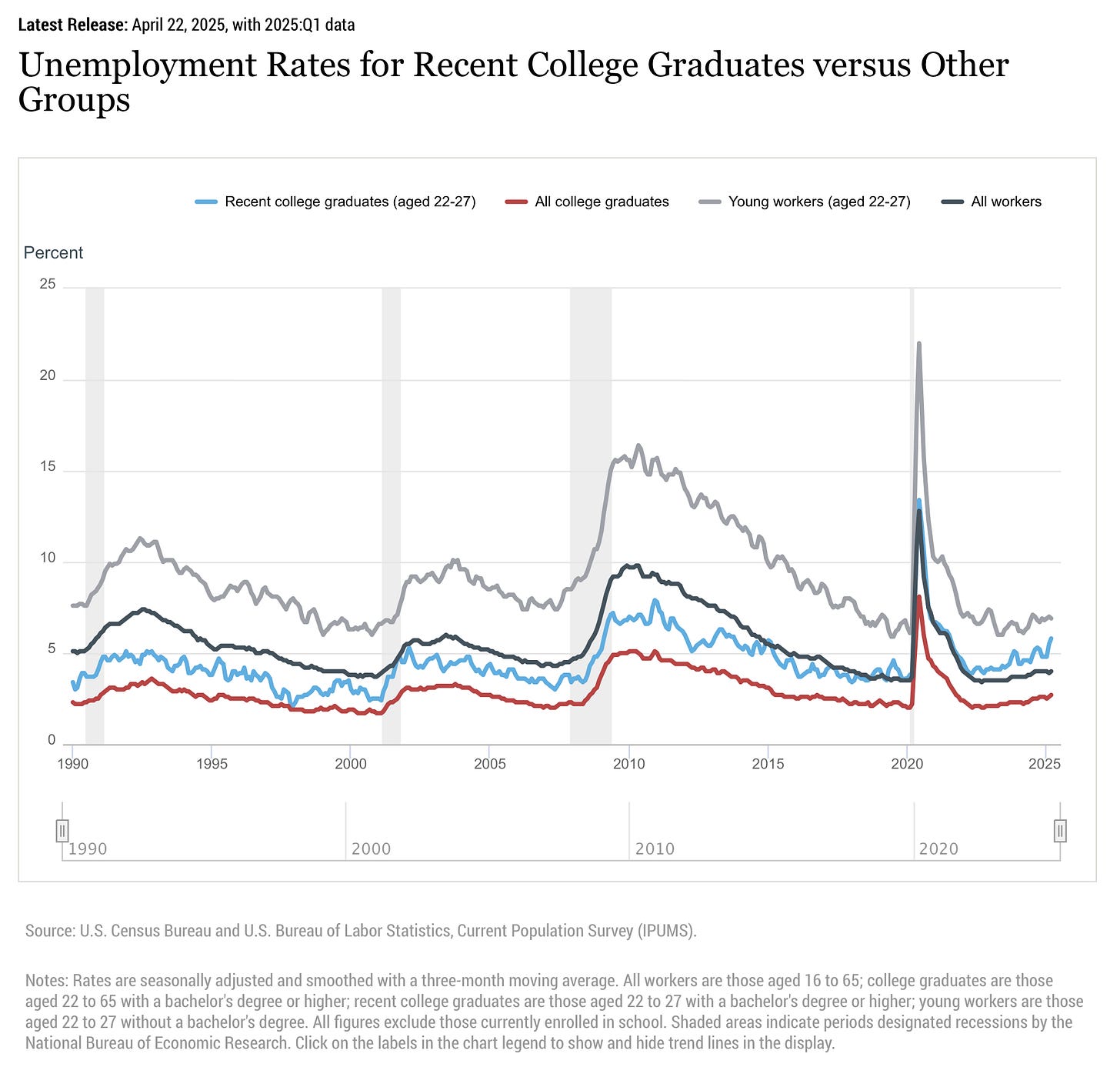The latest social media trend features frustrated Millennials and Gen Xers venting about Gen Z. This time, they are taking on your favorite social media platform to talk about the “Gen Z Stare.” That blank, wide-eyed non-response when Gen Z workers are asked questions is causing problems. Older generations are labeling the stare as awkward and blaming it on underdeveloped soft skills, the impact of COVID-19 on learning environments, and excessive screen time.
But this newsletter isn't about social media trends; it's about economics. The Gen Z stare is a symptom of something bigger: Gen Z is genuinely struggling in the labor market, primarily because older generations are reluctant to welcome the newest workforce entrants. The stare is just another example of the generational divide.
The Real Problem
Every generation faces workforce transition challenges, but this divide is now showing up in economic data. Gen Z is struggling to find employment, and their transition from education to the workforce has been particularly challenging. What might explain their difficulties? To explain what is happening, we need to discuss unemployment types.
In economics, unemployment typically falls into three categories:
Frictional Unemployment - Job seekers and openings exist, but information gaps prevent matches
Structural Unemployment - Workers lack skills needed for available jobs, often during technological shifts
Cyclical Unemployment - Job losses from economic downturns
Gen Z faces all three simultaneously.
What's Different Now
The Friction Problem
Online job applications seemed like they'd make job searching easier. Instead, they removed all useful friction. When everyone can apply to everything with a single click, employers receive hundreds of applications per posting. It's not about actual skills; it's about the signals of skills. When it is difficult to assess the quality of work of applicants, hiring managers may be less likely to hire them.
Just last week, I attended
’ s dissertation defense—congrats, Dr. A! She presented research showing misalignment between what students perceive their skills to be and what hiring managers think is needed for success in entry-level jobs. Her work reveals a significant information gap between these perceptions.I expect that this perceived skills gap tends to widen during periods of market uncertainty, which is exactly where we are now.
Structural Changes
AI is reshaping entry points for white-collar professionals in IT, finance, and law. These are traditional stepping stones for college graduates. If AI can handle junior-level tasks, why hire entry-level workers?
Market Uncertainty
While AI gets the headlines, market uncertainty may be the bigger culprit. Uncertainty often hurts entry-level white-collar workers the most, and that's exactly what we're seeing. The data shows that more educated Gen Zers are struggling disproportionately.
The Historic Shift
For over four decades, college graduates have enjoyed unemployment rates below the national average. That trend has now reversed for the first time. Recent graduate unemployment has risen above the national average. This is a surprising and concerning shift.
To be clear, education remains a valuable investment. Young people without degrees still face higher unemployment than recent graduates. However, college graduate unemployment is rising faster than it should, and that's a new trend.
What This Means
For Gen Z: You need stronger signals to hiring managers. That means old-fashioned networking and referrals. You'll need to communicate your value and cultural fit more clearly. Sorry, every generation has had to adapt to the expectations of those with market power, the people making decisions. Any deviations from the “norm” will be perceived as a mismatch.
For Millennials and Gen X: You need to work harder to open doors for Gen Z. The sooner they enter the market, the more you benefit from their skills and energy. Take risks on them, just as Boomers took risks on you. As
noted in her defense, there's an expectation now that Gen Z must be "day-one ready" that didn't exist for previous generations. Bring back onboarding and training programs.The Takeaway
The Gen Z stare might be awkward, but it's not really about soft skills. It's about a generation caught in a perfect storm of technological disruption, information asymmetries, and market uncertainty. The social media trend is another example of how incumbents attempt to maintain their market share in response to entrants in the market.
I wouldn’t be here today if mentors and leaders hadn't taken me under their wings and taught me how to navigate the workplace. Perhaps fewer videos highlighting the Gen Z stare and more videos on how to uplift a generation that is sitting on the sidelines because we won’t let them in.
There is another perspective to consider in this discussion. Are millennials and Gen Xers reluctant to adapt to market changes? In education, we often hear how the incoming students are underprepared to transition to college, or is it that we, the educators, are underprepared to welcome the new generation of students? Who we blame for the mismatch defines how we solve the problem.
So here's my question: Is the rise in recent graduate unemployment a leading indicator of where the broader economy is headed?
Let's talk about it.
— Dr. A
What is the Gen Z Stare?
Here is a TikTok for those wanting an example of the stare
 Tiktok failed to load.
Tiktok failed to load.Enable 3rd party cookies or use another browser





This reminds me of the show The White Lotus, where generations at a resort try to navigate life with different communication styles, norms, and beliefs—and the stares! I also believe the Gen Z stare isn’t a symptom of weakness, it’s a signal. Could we entertain a counterpoint? Maybe they’re not disengaged, maybe they’re processing before responding, choosing to add value rather than clutter . If I notice it, I tend to ask, 'What are you thinking? Tell me more," and then we connect!
In my classes, there is no opportunity for the stares; it is fast-paced, and engagement is not only required in this setting, it is also practiced through my learn-by-doing pedagogy and UDL principles, which focus on developing communication skills (research shows😉).
I am excited to follow this conversation!
I greatly appreciate how you’ve highlighted how Gen Z need to send stronger signals by using more old-school methods, i.e networking and referrals.
The concept of “day one ready” might be an illusion. For Gen Z, with little or no experience, there still is the time to learn, understand, and properly apply what they’ve learned in the classroom to their work. Onboarding and training still matter.